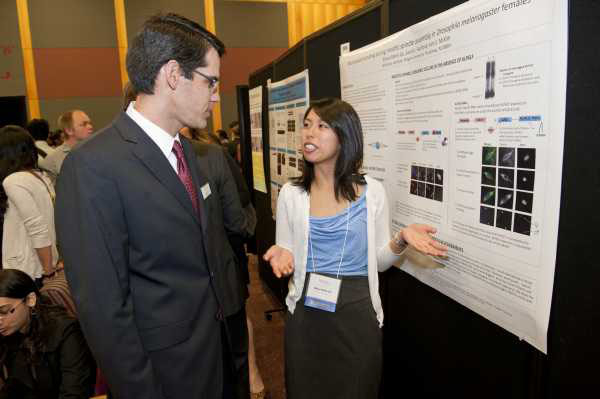More than 500 student posters on exhibit April 25 at Livingston Student Center
For the past decade, the benefits of a public research university have been exhibited annually at Rutgers’ Aresty Undergraduate Research Symposium, where more than 2,000 students have had the opportunity to showcase the results of their work in areas that span the humanities, social sciences, technology, and life and physical sciences.

This year’s 10th anniversary research symposium, which takes place Friday, April 25, at the Livingston Student Center, will feature the research of more than 500 students. To conduct their own independent study, these undergraduates have taken advantage of mentoring provided by Rutgers faculty whose research bridges diverse fields.
“The range of research offerings at Rutgers is wide, in the disciplines that students pursue as well as the geographical scope of their work – from the local community to the international realm,” said Brian Ballentine, the newly appointed director of the Aresty Research Center.
Highlights of this year’s program include a political science student’s contribution to his professor’s biography of William Penn, a genetics student examining the progression of Alzheimer’s disease, a French and art history student examining the trial of Nazi army captain Klaus Barbie, and a cell biology and neuroscience and economics student modeling mental health disorders with stem cells.
Ballentine and Chuck Keeton, associate professor of physics and astronomy and faculty director of the Aresty Center, believe that the program is successful because students are exposed to research possibilities as soon as they begin their academic careers at Rutgers. It starts with Aresty Byrne seminars that introduce first-year students to research topics in small classes taught by senior faculty and is followed by research assistantships that begin in the second year where professors mentor students in research principles and techniques. Finally, students are given the chance to continue their research until graduation while mentoring younger students involved in the program.
In Keeton’s experience, professors are happy to give appropriate credit to their student researchers. “That might be anything from an acknowledgement in papers or presentations to coauthorship, depending on the level of involvement,” he said. “Some students have even been first authors on journal articles.”
The symposium runs from 10:30 a.m. until 2 p.m. on Friday, April 25, in the Livingston Student Center. Students interested in participating in Aresty research programs can visit the center’s website at aresty.rutgers.edu.
A closer look at four student research projects
What factors may play a role in Alzheimer’s disease? Miriam Lisci, a sophomore genetics major, is working with Associate Professor Mary Konsolaki researching the role that pesticides – whose byproducts represent a major health concern due to their high persistence in the soil – may play in the onset and progression of Alzheimer’s disease. In her studies, Lisci is using Drosophila, commonly known as the fruit fly, to genetically track and study the biochemical, genetic, environmental and behavioral aspects of human diseases like Alzheimer’s. Flies expressing amyloid, the hallmark of Alzheimer’s, are exposed to pesticides and then analyzed for changes in their lifespan or tissue morphology. In addition to pesticides, Konsolaki’s research focuses on how copper or other heavy metal imbalances may affect the toxicity of amyloid plaques, which form due to excess amyloid and disrupt brain functions.
Kunal Garg, a junior majoring in economics as well as cell biology and neuroscience is working with Professor Ronald Hart whose long-term goal is to determine why children with Ataxia-telangietasia (A-T) disease – a rare neurodegenerative disease that leaves children unable to walk by adolescence – have difficulty with movement. Hart’s laboratory has received funding from the A-T Children’s Foundation to obtain blood samples from children being treated at the A-T Clinical Center at John Hopkins – as well as their parents who carry one copy of the damaged gene – and turn them into stem cells that can provide insight into this neurological disease. Garg is working on technologies that can selectively modify the DNA in these cells so that mutated genes – which alter the body’s ability to perform biological functions necessary for good health – can be replaced with normal sequenced genes.
William Penn is a founding father whom most Americans have heard of – he established the colony of Pennsylvania in 1681 – but details of his early life remain sketchy. Jeff Niesz, a junior majoring in political science and history, is contributing to a biography of Penn that political science Associate Professor Andrew Murphy plans to publish in 2018, the 300th anniversary of Penn’s death. Niesz chose to investigate Penn’s education from primary through law school – detective work made challenging because many records have been lost over the course of centuries. Niesz contacted archivists at storied institutions across England, such as Oxford and Lincoln’s Inn, and uncovered important details about what Penn studied and who influenced him. Niesz’s research is providing Murphy with insight into how Penn’s early life shaped his vision of American colonies as places where people persecuted in Europe could worship as they saw fit.
After decades of hiding in Bolivia, Nazi army captain Klaus Barbie went on trial in France for crimes against humanity that he committed while head of the Gestapo in Lyon. Those 1987 proceedings were deemed too sensitive and volatile to run on live TV, so they were recorded and released 20 years later. Olympia Christofinis, a junior majoring in French and Art History, was just the student Professor Michael Levine needed to examine those video recordings, all in French with no subtitles, for his research on visual representation of the trials and traumas of World War II. Christofinis looked at how the Barbie trial reminded the public of political divisions that lurked beneath the veneer of solidarity during Germany’s occupation of France and how Barbie’s defense attorney essentially put the French government on trial for its colonial atrocities in Algeria.